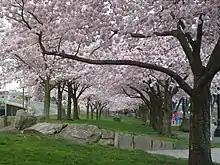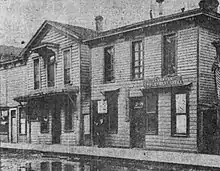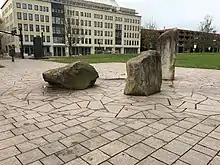History of the Japanese in Portland, Oregon
The history of ethnic Japanese in the Portland, Oregon area dates back to the 19th century.

History

The first historical record of Japanese in the Portland area is that of the three castaways Iwakichi, Kyukichi, and Otokichi, who lived for several months at Fort Vancouver in 1834. They were the sole survivors of a Japanese rice transport ship that had been caught in a typhoon, damaged, and blown far off course. After more than a year at sea, their rudderless ship finally beached on the northwest corner of the Olympic Peninsula, where they were briefly enslaved by the indigenous Makah people. Upon hearing of the three Asian captives, John McLoughlin, the Chief Factor (agent) for the Columbia District at the Hudson's Bay Company, secured their release and had them delivered to Fort Vancouver. They stayed there, along the banks of the Columbia River, for several months before eventually heading to London and then back to Asia.[1]
The first person of Japanese descent to settle in the Portland area is said to have been Miyo Iwakoshi, who moved to Gresham with her Scottish husband and daughter in 1880.[2]
Portland once had two Japantowns: one located in Northwest Portland's Old Town Chinatown area and the other in Southwest Portland.[3] Before World War II, the Japantown in the Northwest District was home to more than 100 businesses, and was Oregon's largest Japantown.[2]
In February 1942, shortly after the Japanese attack on Pearl Harbor, President Franklin D. Roosevelt issued and signed Executive Order 9066, clearing the way for the mass incarceration of all persons of Japanese ancestry on the American West Coast in inland concentration camps. More than 3600 ethnic Japanese from the Portland region were first ordered to a hastily constructed internment facility, the Portland Assembly Center, on the grounds of the Pacific International Livestock Exposition in Portland's Kenton neighborhood.[4] From there, most were sent in groups by rail to the Minidoka Relocation Center in Idaho, following the completion of that camp's construction.[2] Smaller numbers were sent from the assembly center to the Heart Mountain Relocation Center in Wyoming and the Tule Lake Relocation Center in California.[5] Those internees who returned to Portland following the closure of the camps found that Portland's once bustling Japantowns were gone.[2]
Businesses and gardens

Portland's Buckman neighborhood is home to Ota Tofu Company, which opened in 1911 and has been described as the oldest existing tofu shop in the United States.[6]
In 1998, the supermarket chain Uwajimaya opened its first store outside of Washington state near the Beaverton high-tech corridor.[7]
In 2013, the Portland Japanese Garden was deemed to be the finest public Japanese garden in North America out of more than 300 such gardens surveyed by Japanese garden experts.[8] Iyo Stone is installed in the garden.
Monuments and public art
Tom McCall Waterfront Park features the Japanese American Historical Plaza.[9] Friendship Circle, also installed along Waterfront Park, celebrates the sister city relationship between Portland and Sapporo. The artworks Festival Lanterns and Voices of Remembrance also commemorate Portland's Japanese American history. The Ainu and Native American power boards are installed outside the Oregon Convention Center.
See also
References
- Tate, Cassandra (2009-07-23). "Japanese Castaways of 1834: The Three Kichis". HistoryLink.org.
- Dowsett, Libby (2019-01-11), "When Portland had the largest Japantown in Oregon", Street Roots, retrieved 2011-09-01
- Jelsing, Nadine. "Oregon's Japanese Americans: Beyond The Wire". Oregon Public Broadcasting. Retrieved 2020-04-03.
- Sakamoto, Henry Shig. "Portland (detention facility)". Densho. Retrieved June 21, 2020.
- The Evacuated People: A Quantitative Description. United States Department of the Interior. 1946. p. 11. ISBN 978-0404580032.
- Anderson, Heather Arndt (2017-09-18). "The Secret History of America's Oldest Tofu Shop". Slate. The Slate Group.
- Germain, Shanna (2003-07-04). "Asian Tiger". Portland Tribune. Archived from the original on 2003-11-22. Retrieved 2006-09-13.
- "North America's Best Japanese Gardens" (PDF). Sukiya Living Magazine (JOJG). Retrieved June 18, 2020.
- Hidalgo, Carolina (2010-07-30). "Twenty years of Japanese American waterfront memorial to civil rights". The Oregonian. Retrieved 2020-04-03.
